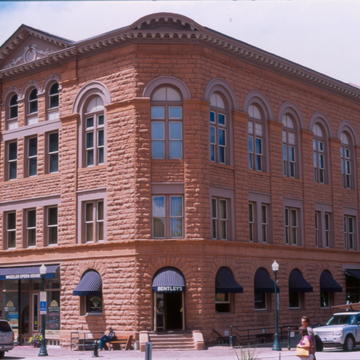Rough-faced Peach Blow sandstone walls and Romanesque Revival detailing distinguish this three-story corner landmark. A strong, banded cornice of smooth stone separates ground-floor storefront businesses from the tall, arcaded bays of the upperlevel opera house. Aspen's early benefactor, Jerome B. Wheeler, lavished a fortune on the interior, and subsequent Aspenites have lionized it as proof of their early cultural proclivities. Willoughby Edbrooke, a Chicago architect noted for the design of the Old Post Office in Washington, D.C., and Denver's now-demolished Tabor Grand Opera House, worked on the Wheeler with his younger brother, Frank.
During Aspen's dim decades, the opera house was usually dark, and it suffered heavy fire damage. In 1949 the Paepckes leased it and had Herbert Bayer modernize it. Now owned by the city, it is gloriously resplendent, following a $4.5 million restoration which erased Bayer's work and other updatings to return the building to 1889. Decorative treatments include stenciling and wood graining by Grammar of Ornament, Denver. Reflecting Aspen's silver era, the elegant horseshoe balcony, gilded boxes, and leather seats shimmer beneath a huge chandelier and a beamed ceiling with silvery stars. On the more subdued exterior, Wheeler's storefront corner bank has become a splendiferous saloon with an adjacent storefront space housing Aspen's visitor information center.










